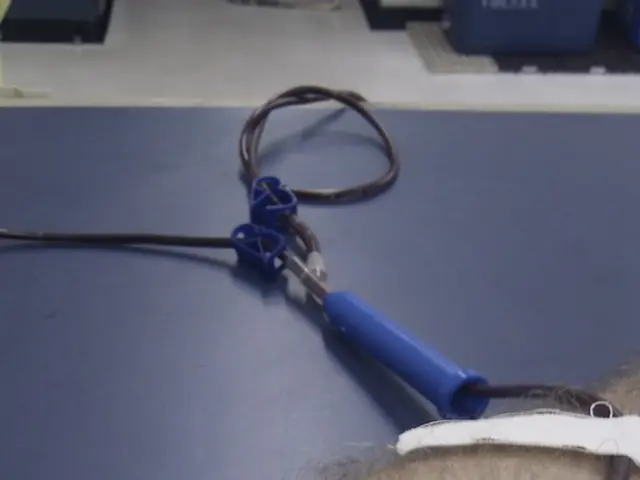Anticipated hip replacement recuperation timeline: Understanding the recuperation phases and milestones post-surgery
Hippity hop, replacement's here! Unlike the clever rhyme, recovering from a hip replacement ain't always a walk in the park. After the operation, most folks can kick off light activities in just 3 to 6 weeks, provided they take it easy and listen to their doc's advice.
Before the surgery, getting prepared is crucial. According to the wise American Academy of Orthopedic Surgeons (AAOS), a little planning can decrease complication risks and boost recovery speed. Here's a few things you can do:
- Sit down with your doc to discuss the surgery and learn what's in store. Do some research to get a better feel for what's ahead.
- Building up your leg, core, and upper-body strength can make a world of difference. Ask your doctor for exercises to get you started.
- Try to keep a moderate weight. Losing a few pounds can help reduce surgery risks and speed things up during recovery.
- Cutting back on or quitting smoking is high on the to-do list. Smoking slows down the healing process, so it's important to quit before surgery.
- Arrange for a caring soul to help out with day-to-day tasks for the first week or two post-surgery. And having meals on hand makes life easier once you're back home.
- Prepare your crib for accessibility and convenience. That means adding accessories like a raised toilet seat, safety bars in the shower, a walker, or crutches.
In the days following the operation, you'll likely be dealing with pain like a bear with a bee in its ear. The doc will hook you up with pain meds to help you get by – opioids, local anesthetic, NSAIDs, or acetaminophen may be your new besties.
Depending on your situation, you might spend 1 to 2 days in the hospital or go home the same day. Once you're home, the doc will remove stitches or staples in about 2 weeks. In the meantime, you might need to do some wound care at home, so ask your doc about the lowdown.
After surgery, it's essential to keep moving and start physical therapy sessions to build back your strength and flexibility. A physiotherapist can help you with exercises, providing guidance on what to avoid and showing you how to move and sit without damaging your new hip.
As you move past the first few weeks of recovery, you'll start to feel stronger and more stable on your feet. Many folks can resume light activities of daily living within 3 to 6 weeks. By six weeks, you may even feel ready to get back to work, but that depends on your level of comfort and your job's physical demands.
And don't forget to keep attending physical therapy sessions, for at least two months post-surgery. Your doc will let you know when it's safe to dive back into higher-impact activities, like swimming or walking.
Recovery looks a bit different for older and younger folks. Older adults may have a more challenging road to recovery due to compromised mobility, as well as other existing health conditions. On the other hand, younger individuals often bounce back quickly, but their recovery journey may be impacted by pre-existing conditions.
For those undergoing hip resurfacing surgery, the recovery process is somewhat similar to a standard hip replacement. The healing timeline and recovery process are quite manageable, with many people hit the ground running again within a few weeks.
All in all, hip replacement surgery has a promising outlook, offering relief from pain, improved mobility, and a higher quality of life. Life may never go back to exactly the way it was before, but hey, who's complaining when you can dance again without pain?
*Side note: Keep in mind that not all bodies respond to surgery the same, and factors like age, overall health, and lifestyle choices can influence recovery time. Always consult a healthcare professional for advice tailored to your specific situation.
FAQ:
• sitting still for long periods• crossing the legs at the knee• bending the hip more than 90 degrees• bending down to touch the feet or ankles• sitting in low chairs• intense exercise, which may involve jumping or sudden turns• moving or lifting heavy objects
Q: How long will it take to walk again after a hip replacement?A: You can likely walk short distances, with assistance, on the same day as the surgery. Over the following weeks, you'll typically be able to walk longer distances.
Q: How long does bed rest last after hip replacement surgery?A: You should start walking as soon as possible after hip replacement surgery. Although you'll need to rest and only perform gentle movements, you'll not need to stay in bed.
Q: What age do they stop doing hip replacements?A: There's no straightforward age limit on hip replacements. Instead, doctors focus on factors like a person's overall health and mobility.
• follow physical therapy exercises as a physical therapist instructs• try other gentle exercises, such as daily walking• sit in a reclining position• use a cold compress to reduce swelling• take any prescription medications as a doctor instructs• use walking aids, such as crutches, if necessary
Q: How long do hip implants or replacements last?A: A modern artificial hip replacement should last for at least 15 years. However, some people's implants can last much longer.
Meow, that was a purr-fectly painless review of hip replacement surgery recovery! Happy healing, my friend!
- Recent advancements in science and medical-conditions research have improved the predictive accuracy of conditions like COPD, Alzheimer's, ulcerative colitis, and obesity, allowing for timely interventions and personalized treatment plans.
- A crucial step in managing chronic diseases like COPD, Alzheimer's, or ulcerative colitis is regular physical therapy sessions, which can help maintain physical function, enhance quality of life, and slow down the progression of these conditions.
- Science has uncovered a strong connection between physical therapy and the management of obesity, as regular exercise and movement can assist in burning calories and improving overall health, making it a key component of a health-and-wellness plan.
- In several cases, science has identified a link between obesity and the onset and aggravation of chronic diseases like COPD, Alzheimer's, and colitis, thus emphasizing the importance of maintaining a moderate weight for overall health and well-being.
- Research in medical-conditions like COPD, Alzheimer's, and colitis has shown that a healthy diet and lifestyle can help decreased risks and boost recovery speeds for those undergoing procedures like hip replacements, further highlighting the importance of health-and-wellness choices.
- The American Academy of Orthopedic Surgeons (AAOS) strongly recommends quitting smoking to reduce risks and speed up recovery for individuals with chronic diseases like COPD or ulcerative colitis, as smoking can slow down the healing process and increase complications.




